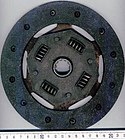Koppling (bildel)
| Den här artikeln behöver källhänvisningar för att kunna verifieras. (2019-07) Åtgärda genom att lägga till pålitliga källor (gärna som fotnoter). Uppgifter utan källhänvisning kan ifrågasättas och tas bort utan att det behöver diskuteras på diskussionssidan. |

Koppling är en anordning som monteras mellan motorn och växellådan i manuellt växlade bilar.
Kopplingen består av en eller flera lameller med friktionsbelägg som pressas mot en stålskiva av kraftiga fjädrar vilket i körläge ger en direkt drivning mellan motor och växellåda. När kopplingspedalen trampas ned minskas tryckplattans press mot lamellen gradvis och kopplingen börjar slira. När pedalen är fullt nedtrampad är motorn så gott som helt frikopplad från växellådan. I tidiga bilar var konstruktionen konformad för att ge en så stor friktionsyta som möjligt. Därför hängde parallellbenämningen kona länge med för kopplingen.
På bilar sitter det i allmänhet en torrlamell, medan det på motorcyklar och mopeder är vanligare att lamellen och hela kopplingshuset är nedsänkt i ett oljebad. På bilar är det också oftast bara en lamell, medan motorcyklar och mopeder brukar ha flera. Orsaken till skillnaden mellan bilar och tvåhjulingar är bland annat att den enkla konstruktionen som finns på bilar hade varit för tung att påverka med händerna. Bilar har i det avseendet en kopplingspedal medan MC/moped har ett kopplingshandtag, i stort sett det omvända gäller med avseende på hur växellådan kontrolleras.
Kraftöverföringen mellan pedal och koppling kan vara mekanisk, hydraulisk eller semi-hydraulisk.
Materialet i kopplingslamellen är för övrigt närbesläktat med bromsbelägg, som även de har en liknande funktion. Asbest som beläggmaterial förbjöds under tidigt 1980-tal.
För byte av lamellen (och tryckplatta/urtrampningslager) i en koppling underlättar det om man använder en centreringsdorn.
På racingmotorcyklar är det vanligt med torrkoppling, bland annat inom Road Racing. Ducati har även torrkoppling på en del av sina gatumotorcyklar.
Media som används på denna webbplats
Författare/Upphovsman: Tkgd2007, Licens: CC BY-SA 3.0
A new incarnation of Image:Question_book-3.svg, which was uploaded by user AzaToth. This file is available on the English version of Wikipedia under the filename en:Image:Question book-new.svg
A clutch disc. This is a typical clutch disc. This particular clutch plate was made by Fichtel & Sachs and fits the Ford Taunus V4 engine in a Saab 95/96/97. It has a number of interesting features:
- The large, flat ring that forms the perimeter of the clutch is the lining. There are two such rings, one on each side. Their surface material is similar to that of brake pads. One lining ring makes frictional contact with the pressure plate, the other faces the flywheel. Clutch discs typically have an orientation; if they are installed backwards, the clutch will not operate properly.
- The lining rings are riveted onto the blades of a fan-shaped part which can only be partially seen in the image. This is called the marcel, and the blades of this part are the marcel springs, not to be confused with the plainly visible coil springs surrounding the center hub. Like the blades of a fan, the marcel springs are somewhat twisted, and the lining rings are riveted to these blades in such a way that when the disc is squeezed between the flywheel and pressure plate, the twisted blades flatten, allowing the disc to compress. A compressible clutch disc provides smoother, more gradual engagement, and reduces chatter.
- Each of the six marcel spring blades has two holes for mounting the lining rings, one hole for each ring. Thus six rivets attach each lining ring to the marcel. In this picture, twelve rivets are visible around the facing ring, but on closer inspection, it's obvious that six of them are deeply recessed: they are in fact rivets belonging to the opposite ring on the other side, visible through large holes in the facing ring. These holes in one ring provide tool access for mounting the other ring to the marcel. This attachment pattern allows the marcel blades to twist and flatten when the rings are compressed together.
- The teeth of the center hub are plainly visible. These fit into splines on the transmission input shaft. By means of these teeth, the disc forces the shaft to rotate, but can move back and forth on the shaft freely. It is possible for the shaft or hub to rust, causing the disk to become stuck to the shaft, which results in intermittent difficulties in shifting.
- A number of 4 coil springs are visible, arranged in a circular pattern around the hub. These damper springs provide elasticity between the toothed center hub and the clutch disc. That is to say, the hub can be slightly rotated independently of the disc, a motion which is stiffly opposed by the compression of these springs. The springs provide cushioning between the engine and transmission, helping to absorb the forces of sudden engagement and vibration.
- The coil springs are held in place by metal folds, cut and bent out from the center plate. One mode of clutch failure is that these folds can wear out, allowing a spring to fall out and become lodged in the clutch, preventing engagement. On two of the springs wear spots can be clearly seen.
- Clutch discs typically do not have individually serviceable parts. When a clutch is serviced, the entire disc is replaced as a unit. The lining, marcel springs and damper springs and their housing all are subject to fatigue and wear. A high quality clutch that is operated correctly can last well in excess of 200,000 kilometers.
- Either the marcel or damper springs or both may be absent from clutches used for racing, for greater strength, lighter weight and faster shifting.

